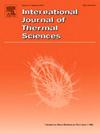Numerical simulation of ice slurry fluid flow characteristics and transport capability in the Flat-Sided Oval Pipe
IF 4.9
2区 工程技术
Q1 ENGINEERING, MECHANICAL
International Journal of Thermal Sciences
Pub Date : 2025-05-09
DOI:10.1016/j.ijthermalsci.2025.109976
引用次数: 0
Abstract
Ice slurry due to good characteristics such as fluidity and high energy capacity is one of the common methods in Cold Thermal Energy Storage (CTES). In this study, 3D numerical simulations were carried out using the Eulerian-Eulerian multiphase model to investigate the flow pattern, pressure drop, particle distribution, and related factors in the ice slurry flow. These investigations were conducted within both circular and Flat-Sided Oval Pipe (FSOP) cross-sections with L/H (aspect ratio of cross-section) ratios of 1, 2, and 3. Using FSOP compared to a circular cross-section while maintaining the hydraulic diameter leads to an increase in the pipe's wetted area. The study takes into account a 10.3 wt% ethanol-water solution as a carrier fluid and mass fractions of 10 % and 15 % for ice particles. The increase in entrance region and pressure drop are directly related to the L/H ratio. The results of this study show that in the best case, where L/H = 1, when FSOP cross-section compared to a circular pipe, the wetted area (Aw) increased by 63.7 %, while the increase in pressure drop (Pd) was 1.6 % and 1.3 % for ice mass fractions of 10 % and 15 %, respectively. The ratio between these two parameters, Aw/Pd, showed approximately a 61 % increase for 10 % and 15 % ice mass fraction. In the circular cross-section the ice particles tend to accumulate on the upper side of the pipe cross-section and near the wall, while in FSOP, the particles are pushed out of this central region on the two symmetrical sides near the wall. The study shows that the transport capability is directly proportional to the L/H ratio, inlet velocity, and ice mass fraction. The transport capability within the FSOP cross-section compared to the circular pipe, demonstrates about a 75 % improvement.

冰浆流体在平边椭圆管内流动特性及输运能力的数值模拟
冰浆由于具有良好的流动性和高能量容量等特性,是冷热能储能的常用方法之一。本研究采用欧拉-欧拉多相模型进行三维数值模拟,研究冰浆流动过程中的流态、压降、颗粒分布及相关因素。这些研究在圆形和平边椭圆管(FSOP)截面内进行,截面长径比为1、2和3。在保持液压直径的同时,使用FSOP与圆形截面相比,会增加管道的湿润面积。该研究考虑了10.3%的乙醇水溶液作为载液,冰颗粒的质量分数为10%和15%。入口面积的增大和压降与L/H比直接相关。研究结果表明,在L/H = 1的最佳情况下,与圆管相比,当冰质量分数为10%和15%时,湿化面积(Aw)增加63.7%,压降(Pd)分别增加1.6%和1.3%。当冰质量分数为10%和15%时,这两个参数之间的比值Aw/Pd增加了约61%。在圆形截面中,冰粒子倾向于聚集在管道截面的上部和靠近管壁的地方,而在FSOP中,冰粒子则在靠近管壁的对称两侧的中心区域被推出。研究表明,输运能力与L/H比、入口速度和冰质量分数成正比。与圆管相比,FSOP横截面内的输送能力提高了约75%。
本文章由计算机程序翻译,如有差异,请以英文原文为准。
求助全文
约1分钟内获得全文
求助全文
来源期刊

International Journal of Thermal Sciences
工程技术-工程:机械
CiteScore
8.10
自引率
11.10%
发文量
531
审稿时长
55 days
期刊介绍:
The International Journal of Thermal Sciences is a journal devoted to the publication of fundamental studies on the physics of transfer processes in general, with an emphasis on thermal aspects and also applied research on various processes, energy systems and the environment. Articles are published in English and French, and are subject to peer review.
The fundamental subjects considered within the scope of the journal are:
* Heat and relevant mass transfer at all scales (nano, micro and macro) and in all types of material (heterogeneous, composites, biological,...) and fluid flow
* Forced, natural or mixed convection in reactive or non-reactive media
* Single or multi–phase fluid flow with or without phase change
* Near–and far–field radiative heat transfer
* Combined modes of heat transfer in complex systems (for example, plasmas, biological, geological,...)
* Multiscale modelling
The applied research topics include:
* Heat exchangers, heat pipes, cooling processes
* Transport phenomena taking place in industrial processes (chemical, food and agricultural, metallurgical, space and aeronautical, automobile industries)
* Nano–and micro–technology for energy, space, biosystems and devices
* Heat transport analysis in advanced systems
* Impact of energy–related processes on environment, and emerging energy systems
The study of thermophysical properties of materials and fluids, thermal measurement techniques, inverse methods, and the developments of experimental methods are within the scope of the International Journal of Thermal Sciences which also covers the modelling, and numerical methods applied to thermal transfer.
 求助内容:
求助内容: 应助结果提醒方式:
应助结果提醒方式:


